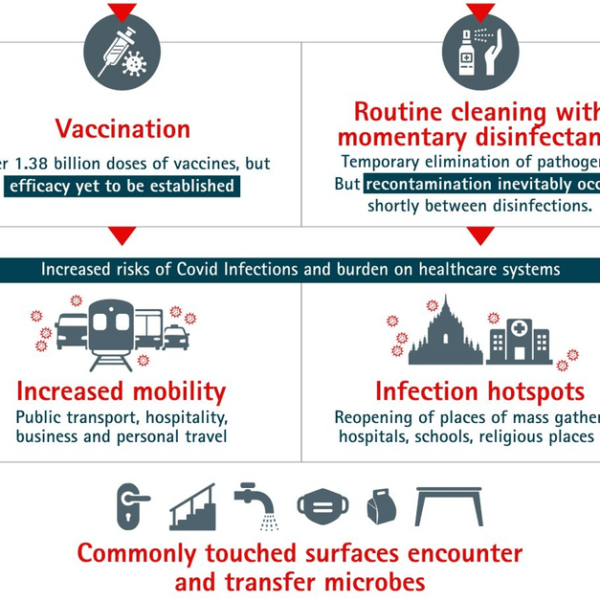Copper's crucial role in the bio and economic burden caused by COVID-19
The ongoing contagion has reinstated the importance of surface disinfection, hygiene, and safety, especially in public infrastructure.
This is an exceptional milestone for the country especially in light of the onset of the fast-spreading Omicron variant. During the second wave of cases in April 2021, the healthcare infrastructure was stretched to its limits as critical medical supplies dwindled while the number of active infections spiraled, contributing to a significantly higher death count. Within this period, rapid community transmission of double mutant and triple mutant strains of SARS-CoV-2 was also observed across the nation. Current vaccine responses and the efficacy of existing vaccines against omicron are yet to be determined[1]. As a result, the ongoing contagion has reinstated the importance of surface disinfection, hygiene, and safety, especially in public infrastructure. Individuals have become more conscious of the criticality of hand hygiene, as well as the relevance and importance of surface disinfection.
Increased mobility due to the ease of COVID-19 related restrictions in recent months has brought a renewed focus on hygiene and safety in public infrastructure. Since these are places of mass gathering, places such as hospitals, public transport, religious institutions are likely hotspots of infection. They harbor commonly touched surfaces and objects that are likely reservoirs from which individuals can encounter and transfer microbes. In healthcare institutions, objects frequently touched by healthcare workers, patients, and visitors can serve as cesspools of contamination. Hence, there is a need for long-term and sustainable solutions for safe public infrastructure beyond periodic disinfection of surfaces.
In recent decades, various studies have showcased a way to convert these high-touch surfaces used by microbes to spread from person to person into weapons against them. They have demonstrated the use of antimicrobial surfaces as self-disinfecting and infection control tools in public infrastructure. Antimicrobial is the ability of a substance to kill or inactivate microbes, such as bacteria, fungi (including molds), and viruses. Routine disinfection of surfaces only results in a temporary elimination of pathogens, and recontamination inevitably occurs shortly between disinfections. Hence, this necessitates the need for antimicrobial strategies beyond routine learning with momentary disinfectants.
The need for antimicrobial strategies beyond routine cleaning with momentary disinfectants is necessary
In February 2021, the Environmental Protection Agency (EPA) of USA announced that certain copper and its alloys provide long-term effectiveness against viruses, including SARS-CoV-2, the virus that causes COVID-19. It has been revealed that SARS-CoV-2 is no longer infectious on alloys made of 95.6 percent copper within two (2) hours, while it can survive on plastic surfaces for up to 72 hours. The inherent biocidal properties of copper surfaces offer a theoretical advantage to conventional cleaning, as the effect is continuous rather than episodic. India’s public health infrastructure is not fully equipped yet to handle pandemics, as has been demonstrated by the shortages in critical medical supply and services faced by people during the second wave.
Hence, upgrading critical surfaces such as IV poles and bed rails in hospitals, door handles, etc. in public places to antimicrobial copper can potentially reduce infection rates. Consequently, this strategy can alleviate some strain on the economy during challenging times such as a pandemic. Some government departments and government-supported institutes have already taken cognizance of the relevance of antimicrobial surfaces in public infrastructure. For instance, Indian Railways plans to introduce ‘Post-COVID Coaches’ equipped with copper-coated handrails and latches. Further, institutes like IIT have developed an antimicrobial food wrapping material as well as a spray-based antimicrobial coating for PPE such as face masks.
Thus, antimicrobial surfaces are gaining prominence amongst both the public and private sectors. There is a growing demand for the use of antimicrobial copper in transit, commercial spaces, sports facilities, and most importantly, healthcare infrastructure, to defeat the spread of contaminations. In this regard, antimicrobial copper can be incorporated into buildings as part of the building fabric, furniture or at specific touchpoints as straightforward and cost-effective methods of controlling and preventing infection in a wide range of applications to contribute towards the reduction of bioburden.
As our nation continues to battle with the ongoing pandemic, it is imperative that initiatives such as those mentioned above be adopted and scaled up across the country to ensure a sustainable and sustained solution for a safe and hygienic India. Dual purpose’ antimicrobial surfaces/products such as doorknobs, handrails, taps, etc. require no additional measures, staff training, or specific maintenance. Hence, not only can they contribute to a reduction in maintenance and labor costs, but their adoption in public infrastructure can also help reduce the environmental impact of using cleaning and disinfecting agents in these places.
It is also imperative, at this time, for the industry to come together to increase antimicrobial copper products. Currently, the industry is highly fragmented and copper products for public health are being produced in an ad-hoc manner. However, the industry has the appetite and the intention to support the country in its fight against the pandemic and should be able to come together to increase bioburden-reducing materials.
While it is imperative to follow and maintain meticulous cleaning regimes and scrupulous personal hygiene, copper and its alloys antimicrobial surfaces and coatings in buildings are a beneficial additional component that can be used to great effect in the fight against microbes and the current pandemic. They work silently, invisibly, and round the clock. They inactivate bacteria, viruses, fungus and helps to prevent cross-infection, and supports cleaning plans. Therefore, the intrinsic antimicrobial and self-sanitizing properties of copper must be leveraged to especially strengthen our overstretched healthcare infrastructure and better equip the nation for any future pandemics.
Read more about antimicrobial copper at https://www.antimicrobialcopper.org/
By – Mayur Karmarkar, Managing Director, ICA India

